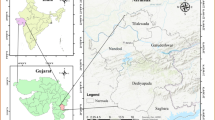Abstract
The water present in the subsurface is considered as a high treasured water source. The present study deals with the delineation of groundwater potential zone in Tirunelveli Taluk, Tamil Nadu, South India. The study area lies between longitude 77°32′16″ to 77°48′8″E and latitude 8°40′12″ to 8°56′34″N with an area of 558.42 km2. The groundwater potential zone of the Tirunelveli Taluk was inferred by the following layers, namely geology, geomorphology, lineament density, drainage density, rainfall, slope, soil and land use/land cover. These layers are digitized with the scale of 1:50,000 in GIS environment from the spatial data sources such as SOI topographic maps, GSI geology map, LANDSAT 8 satellite image, SRTM DEM, Tamil Nadu Agricultural Department daily rainfall data and available existing maps. The weights of the feature layers and ranking of each feature classes arrive from the pairwise comparison techniques of AHP technique. The prepared thematic maps are reclassified based on the influence of the layers feature classes on the groundwater availability. Finally, the reclassified layers are overlaid using weighted overlay tool to prepare groundwater prospect map. The finally this study resulted that 5.76 km2 of the study area is identified as very high groundwater potential. The high potential area covers 382.9 km2, and medium potential zone covers 169.72 km2.












Similar content being viewed by others
References
Colins Johnny J, Sashikkumar MC, Anas PA, Kirubakaran M (2016) GIS-based assessment of aquifer vulnerability using DRASTIC Model: a case study on Kodaganar basin. Earth Sci Res J 20(1):1–8
Gaur S, Chahar BR, Graillot D (2011) Combined use of groundwater modeling and potential zone analysis for management of groundwater. Int J Appl Earth Obs Geoinf 13:127–139
CGWB (2007) A manual on artificial recharge of groundwater
NRSA (2008) A manual on groundwater prospect mapping for Rajiv Gandhi National Drinking water Mission, pp 3–235
Mallick J, Singh CK, Al-Wadi H, Ahmed M, Rahman A, Shashtri S, Mukherjee S (2015) Geospatial and geostatistical approach for groundwater potential zone delineation. Hydrol Process 29(3):395–418
Agarwal E, Agarwal R, Garg RK, Garg PK (2013) Delineation of groundwater potential zone: an AHP/ANP approach. J Earth Syst Sci 122(3):887–898
Huang C-C, Yeh H-F, Lin H-I, Lee S-T, Hsu K-C, Lee C-H (2013) Groundwater recharge and exploitative potential zone mapping using GIS and GOD techniques. Environ Earth Sci 68:267–280
Nag SK, Ghosh P (2012) Delineation of groundwater potential zone in Chhatna Block, Bankura District, West Bengal, India using remote sensing and GIS techniques. Environ Earth Sci 70:2115–2127
Prasad RK, Mondal NC, Banerjee P, Nandakumar MV, Singh VS (2007) Deciphering potential groundwater zone in hard rock through the application of GIS. Environ Geol 55:467–475
Nasiri H, Boloorani AD, Sabokbar HAF, Jafari HR, Hamzeh M, Rafli Y (2013) Determining the most suitable areas for artificial groundwater recharge via an integrated PROMETHEE II-AHP method in GIS environment (case study: Garabaygan Basin, Iran). Environ Monit Assess 185:707–718
Bagyaraj M, Ramkumar T, Venkatramanan S, Gurugnanam B (2013) Application of remote sensing and GIS analysis for identifying groundwater potential zone in part of Kodlkanai Taluk, South India. Front Earth Sci 7(1):65–75
Amer R, Sultan M, Ripperdan R, Ghulam A, Kusky T (2013) An integrated approach for groundwater potential zoning in shallow fracture zone aquifers. Int J Remote Sens 34(19):6539–6561
Hajkowicz S, Higgins A (2008) A comparison of multiple criteria analysis techniques for water resource management. Eur J Oper Res 184:255–265
Jha MK, Chowdary VM, Chowdhury A (2010) Groundwater assessment in Salboni Block, West Bengal (India) using remote sensing, geographical information system and multi-criteria decision analysis techniques. Hydrogeol J 18:1713–1728
Kirubakaran M, Colins Johnny J, Ashokraj C, Arivazhagan S (2016) A geostatistical approach for delineating the potential groundwater recharge zones in the hard rock terrain of Tirunelveli Taluk, Tamil Nadu, India. Arab J Geosci 9(5):382
CGWB (2009) District groundwater brochure Tirunelveli District, Tamil Nadu
Saaty TL (1990) An exposition of the AHP in reply to the paper “Remarks on the Analytic Hierarchy Process”. Manag Sci 36:259–268
Saaty TL, Bennett JP (1977) A theory of analytical hierarchies applied to political candidacy. Behav Sci 22:237–245
Kaliraj S, Chandrasekar N, Magesh NS (2013) Identification of potential groundwater recharge zones in vaigai upper basin, Tamil Nadu, using GIS-based analytical hierarchical process (AHP) technique. Arab J Geosci 7(4):1385–1401
Jayavel Raja Kumar T, Balasubramanian A, Kumar RS, Dushiyanthan C, Karthikeyan K, Thiruneelakandan B, Davidraju D, Manoharan K (2011) Delineating and evaluation of groundwater potential zones using electrical resistivity survey and aquifer performance test in Uppodai of Chittar—Uppodai water shed, Tambaraparani River Basin, Tirunelveli-Thoothukudi District, Tamilnadu. J Ind Geophys Union 15(2):88–94
Acknowledgements
The authors would like to thank Regional Center of Anna University, Tirunelveli, for institutional support to furnish this work, and also authors extend their sincere thanks to Tamil Nadu Agricultural Department for providing rainfall data for the study area.
Author information
Authors and Affiliations
Corresponding author
Additional information
Publisher's Note
Springer Nature remains neutral with regard to jurisdictional claims in published maps and institutional affiliations.
Rights and permissions
About this article
Cite this article
Muniraj, K., Jesudhas, C.J. & Chinnasamy, A. Delineating the Groundwater Potential Zone in Tirunelveli Taluk, South Tamil Nadu, India, Using Remote Sensing, Geographical Information System (GIS) and Analytic Hierarchy Process (AHP) Techniques. Proc. Natl. Acad. Sci., India, Sect. A Phys. Sci. 90, 661–676 (2020). https://doi.org/10.1007/s40010-019-00608-5
Received:
Revised:
Accepted:
Published:
Issue Date:
DOI: https://doi.org/10.1007/s40010-019-00608-5




